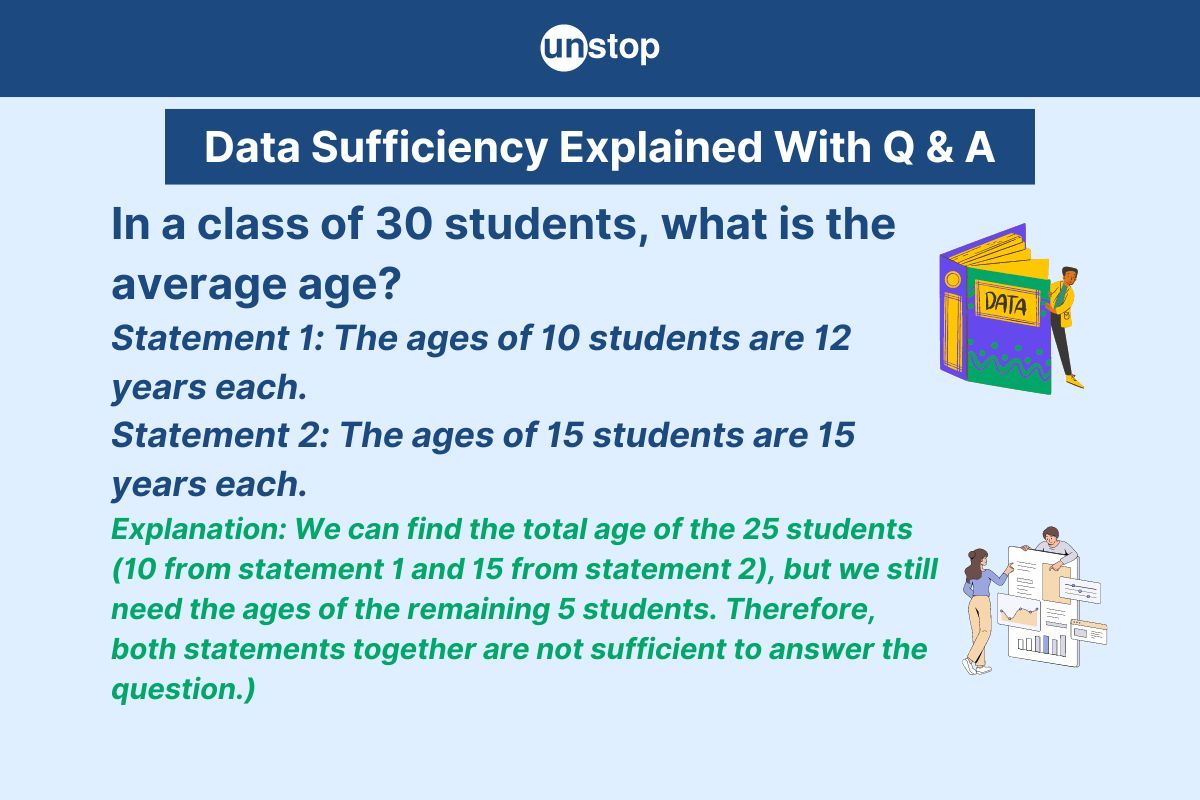- Basics Of Data Sufficiency
- Strategies For Solving Data Sufficiency Questions
- Tips For Solving Data Sufficiency Questions
- Different Types Of Data Sufficiency Problems
- Practicing Data Sufficiency With Sample Questions
- Final Remarks
- Frequently Asked Questions (FAQs)
Data Sufficiency- Concept, Strategy, Selected Questions & Answers

Data sufficiency is a crucial area in logical reasoning for competitive exams in India. It evaluates a candidate's logical, analytical, and thinking skills. To perform well, candidates must practice such questions regularly.
Basics Of Data Sufficiency
To begin with, let us study the definition of data sufficiency:
Definition
Data sufficiency in logical reasoning refers to the ability to determine whether the data provided is adequate to answer a given question. It involves analyzing information and deciding if it is enough to reach a conclusion.
Concepts In Data Sufficiency
Data sufficiency questions commonly test the ability to determine if the information provided is adequate to answer a question. They may involve algebra, geometry, or even logical reasoning. Candidates are required to decide whether the data given is sufficient to solve the problem.

Strategies For Solving Data Sufficiency Questions
Let us study some of the recommended strategies for data sufficiency problems:
Reading Questions
Carefully read the question stem before analyzing the statements. Identify what is being asked and the type of information needed to answer the question accurately. Look for keywords that indicate the type of data required, such as "total," "odd/even," or "sufficient."
Utilizing Prior Knowledge
Leverage your understanding of basic math concepts to simplify complex problems. Break down intricate scenarios into simpler components to evaluate sufficiency effectively. Apply known formulas and rules to assess the sufficiency of individual statements.
Analyzing Statements
Evaluate each statement independently, determining if it provides adequate information to solve the problem. Avoid combining statements prematurely, as they may be sufficient on their own but insufficient when combined. Check for consistency between statements to ensure accuracy.
Importance Of Elimination
When faced with uncertainty, eliminate answer choices that are clearly insufficient based on individual statements. Refine your focus by narrowing down potential solutions through systematic elimination.
Tips For Solving Data Sufficiency Questions
Let us also study some of the tips for solving data-sufficiency questions:

Avoid Mistakes
Avoid assuming additional information beyond what is given when tackling data-sufficiency questions. Focus solely on the provided statements without introducing external data. Misinterpreting the data can lead to incorrect answers.
Interpret Statements
To interpret statements accurately, break down the information into smaller parts and analyze each component separately. Identify key details that impact the solution. Look for relationships or patterns within the statements to determine their significance.
Answer Confidently
Confidence in answering data-sufficiency questions comes from understanding the question's requirements clearly. Ensure you comprehend what is being asked before analyzing the statements. Eliminate options systematically based on whether they provide sufficient data or not.
Different Types Of Data Sufficiency Problems
Let us study two important types of data sufficiency:
Quantitative Data Sufficiency
Quantitative data sufficiency involves math-based questions where test-takers must determine if the provided data is adequate to solve a mathematical problem. These questions often require analyzing numerical data.
Qualitative Data Sufficiency
Qualitative data sufficiency focuses on non-numeric information, such as verbal reasoning or logical reasoning. Test-takers must assess whether the given details are enough to answer a non-mathematical question.
Practicing Data Sufficiency With Sample Questions

Question 1: Five persons – Rina, Meenu, Dev, Rewa and Jaya, each have a different weight. Who among these persons is the heaviest?
Statement I: Only two persons are heavier than Meenu, who is heavier than Jaya and Rewa.
Statement II: Dev, who is not the lightest, is heavier than Meenu and Rewa, but not Rina.
a) Statement I provides enough information to answer the question on its own, while Statement II does not.
b) Statement II provides enough information to answer the question, whereas Statement I does not.
c) Either Statement I or Statement II alone provides enough information to answer the question.
d)When statements I and II are considered together, they are insufficient to provide a clear answer to the question.
e) Both Statement I and Statement II are required to provide a sufficient answer to the question.
Answer: e) Both Statement I and Statement II are required to provide a sufficient answer to the question at hand.
Question 2: Four persons – Arav, Abul, Azal and Azim, are sitting in a straight line facing south. Who is/are sitting adjacent to Arav?
Statement I: Arav does not sit next to Azim, who does not sit on the extreme right.
Statement II: No one sits to the right of Arav and on the left of Abul, while only one person sits between Azal and Abul.
a) To answer the question, both Statements I and II must be considered together.
b) Statements I and II, when combined, do not provide enough information to answer the question.
c) Statement I or Statement II alone is enough to provide an answer to the question.
d) Statement II by itself is enough to provide an answer, whereas Statement I alone does not offer sufficient information to do so.
e) Statement I provides enough information to answer the question, whereas the data in Statement II is insufficient on its own.
Answer: d) Statement II by itself is enough to provide an answer, whereas statement I alone does not offer sufficient information to do so.
Question 3: In a straight line of twenty-five persons facing north, how many persons are sitting between Dan and Hana?
Statement I: Ana sits at the extreme left end of the line. Only six persons sit between Ana and Hana. Only ten persons sit between Hana and Pal. Only four persons sit between Pal and Dan.
Statement II: Maya sits exactly in the middle of the line. Only three persons sit between Rama and Maya. Only six persons sit between Rama and Dan. Rama sits on the left of Dan. Hana sits fourth to the left of Maya.
a) Statement I provides enough data to answer the question, but Statement II does not offer sufficient information for a solution.
b) Statement II provides enough data to answer the question, whereas Statement I does not offer adequate information for a solution to be determined.
c) Sufficient data to answer the question can be found in either statement I alone or statement II alone.
d) When considering both statements I and II, the data provided is insufficient to provide an answer to the question at hand.
e)Both statements I and II are required to answer the question.
Answer: b) Statement II provides enough data to answer the question, whereas Statement I does not offer adequate information for a solution to be determined.
Question 4: How is Mona related to Shilpa?
Statement I: Mona is the mother of Jay. Babu is married to Allan. Shilpa is the daughter of Babu. Allan is the brother of Jay.
Statement II: Mona is married to Vicky. Vicky is the father of Jay. Jay is married to Kalu. Jay is the uncle of Shilpa.
a) Statement I provides enough information to answer the question, whereas the data in Statement II is insufficient for a conclusive answer.
b) Statement II on its own is enough to provide the answer, whereas the information in Statement I alone does not suffice to address the question.
c) Statement I or Statement II alone is enough to answer the question.
d) When considering the question, the combination of statements I and II does not provide enough information for a conclusive answer.
e) To answer the question, both statements I and II are needed.
Answer: c) Statement I or Statement II alone is enough to answer the question.
Question 5: Six persons – Ray, Sumi, Amit, Bilal, Dan, and Jon are sitting in a row facing north. Who among these persons sits on the immediate left of Amit?
Statement I: Amit sits between Ray and Dan, who sits on the extreme right.
Statement II: Amit is third to the right of Jon and second to the left of Bilal.
a) Statement I provides enough information to answer the question, whereas the data in Statement II is insufficient for a conclusive answer.
b) Statement II on its own is enough to provide the answer, whereas the information in Statement I alone does not suffice to address the question.
c) Statement I or Statement II alone is enough to answer the question.
d) When considering the question, the combination of statements I and II does not provide enough information for a conclusive answer.
e) To answer the question, both statements I and II are needed.
Answer: b) Statement II on its own is enough to provide the answer, whereas the information in Statement I alone does not suffice to address the question.
Question 6: In a certain code language, words are coded using the following hints. Find the code for "strike today."?
Statement I: "Strike today or never" is coded as "bo ma su no", and "price never today" is coded as "ki no su".
Statement II: "Price strike low today" is coded as "ki bo su pe", and "today's sale price" is coded as "su ki ba".
a) Statement I provides enough information to answer the question, whereas the data in Statement II is insufficient for a conclusive answer.
b) Statement II on its own is enough to provide the answer, whereas the information in Statement I alone does not suffice to address the question.
c) Statement I or Statement II alone is enough to answer the question.
d) When considering the question, the combination of statements I and II does not provide enough information for a conclusive answer.
e) To answer the question, both statements I and II are needed.
Answer: e) To answer the question, both statements I and II are needed.
Question 7: Seven letters – A, E, F, G, I, L and R- are placed in a straight row from left to right so that no meaningful English word is formed. Find the position of L with respect to F.
Statement I: A is third to the left of G, which is placed exactly in the middle of the word. L is adjacent to A. I is second to the right of F but not adjacent to G.
Statement II: R is to the immediate left of I. F is second to the right of A, which is placed at an extreme left end. L is not placed after G, which is kept exactly in the middle of the row.
a) Statement I provides enough information to answer the question, whereas the data in Statement II is insufficient for a conclusive answer.
b) Statement II on its own is enough to provide the answer, whereas the information in Statement I alone does not suffice to address the question.
c) Statement I or Statement II alone is enough to answer the question.
d) When considering the question, the combination of statements I and II does not provide enough information for a conclusive answer.
e) To answer the question, both statements I and II are needed.
Answer: c) Statement I or Statement II alone is enough to answer the question.
Question 8: Which direction is City G from City B?
Statement I: City G is in the north of City D, which is in the west of City C. City C, A and B form a straight line. City B is towards the north of City C.
Statement II: City B is in the north of City A, which is in the west of City H. City G is towards the south of City F, which is in the east of City H.
a) Statement I provides enough information to answer the question, whereas the data in Statement II is insufficient for a conclusive answer.
b) Statement II on its own is enough to provide the answer, whereas the information in Statement I alone does not suffice to address the question.
c) Statement I or Statement II alone is enough to answer the question.
d) When considering the question, the combination of statements I and II does not provide enough information for a conclusive answer.
e) To answer the question, both statements I and II are needed.
Answer: a) Statement I provides enough information to answer the question, whereas the data in Statement II is insufficient for a conclusive answer.
Question 9: What is the code for "sweet candy"?
Statement I: 'Candy chocolate sweet' is coded as hi ni mi, and 'sweet bite candy' is coded as ti mi ni.
Statement II: 'Drink water candy' is coded as fi mi gi, and 'chocolate sweet water' is coded as ti ni gi.
a) Statement I provides enough information to answer the question, whereas the data in Statement II is insufficient for a conclusive answer.
b) Statement II on its own is enough to provide the answer, whereas the information in Statement I alone does not suffice to address the question.
c) Statement I or Statement II alone is enough to answer the question.
d) When considering the question, the combination of statements I and II does not provide enough information for a conclusive answer.
e) To answer the question, both statements I and II are needed.
Answer: a) Statement I provides enough information to answer the question, whereas the data in Statement II is insufficient for a conclusive answer.
Question 10: Six cars from C1 to C6 participated in a race. Which car stood in first position?
Statement I: C1 finished the race before two cars only. C3 was not the last one to finish the race. C4 finished the race just before C5.
Statement II: No other car finished the race after C6, which finished the race just after C3. C2 finished the race before C3.
a) Statement I provides enough information to answer the question, whereas the data in Statement II is insufficient for a conclusive answer.
b) Statement II on its own is enough to provide the answer, whereas the information in Statement I alone does not suffice to address the question.
c) Statement I or Statement II alone is enough to answer the question.
d) When considering the question, the combination of statements I and II does not provide enough information for a conclusive answer.
e) To answer the question, both statements I and II are needed.
Answer: d) When considering the question, the combination of statements I and II does not provide enough information for a conclusive answer.
Conclusion
You've now grasped the essentials of data sufficiency, from basic concepts to advanced strategies. By mastering these techniques and consistently practising, you'll enhance your skills and confidence in tackling these challenging problems.
Stay focused, keep practising, and watch as your proficiency grows. Best of luck on your data-sufficiency journey!
Frequently Asked Questions (FAQs)
1. What are the key concepts to understand in Data Sufficiency?
Key concepts of data sufficiency include identifying necessary vs. sufficient data, avoiding assumptions, and using logical reasoning.
2. How can I effectively solve Data Sufficiency questions?
Effective strategies for data sufficiency involve understanding the question first, assessing each statement independently, eliminating irrelevant data, and combining information logically.
3. Why is regular practice important for mastering data sufficiency?
Regular practice enhances your analytical skills, improves time management, boosts confidence, and familiarizes you with various question types and patterns in data sufficiency.
4. What are some tips for tackling advanced data sufficiency problems?
For advanced problems, focus on breaking down complex information into manageable parts, honing your critical thinking skills, practising with challenging questions regularly, and seeking expert guidance when needed.
5. How can different types of data sufficiency problems be approached?
Approach different types of data sufficiency problems by categorizing them based on common patterns, practising a variety of question formats, and developing personalized strategies for each problem type.
Suggested reads:
- Puzzle Reasoning- Concept And Strategy With Questions & Answers
- Find The Odd One Out- Reasoning Tricks With Questions & Answers
- Verbal Classification Reasoning With Practice Questions & Answers
- Assertion And Reason- Type, Strategy, Practice Question & Answer
- Statement And Conclusion- Question & Answer In Logical Reasoning
Instinctively, I fall for nature, music, humor, reading, writing, listening, traveling, observing, learning, unlearning, friendship, exercise, etc., all these from the cradle to the grave- that's ME! It's my irrefutable belief in the uniqueness of all. I'll vehemently defend your right to be your best while I expect the same from you!
Login to continue reading
And access exclusive content, personalized recommendations, and career-boosting opportunities.
Subscribe
to our newsletter
















Comments
Add comment